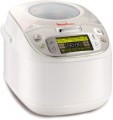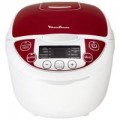Number of programs
The total number of cooking programs provided in the device.
The greater this number — the more extensive the possibilities of the multicooker, the wider the choice of the user. However, note that a specific set of modes may be different, this point in each case should be clarified separately. See "Programs" for details on specific modes. As for specific values, the most modest models nowadays have
up to 10 programs, devices for
10 — 20 programs and even
more are quite popular, and in the most multifunctional solutions this number can be
more than 35.
Modes
The available operating modes of a multicooker provide a reliable indication of what you can typically expect when using the device. Among the main modes there are
warming up,
free mode,
express,
steaming,
stewing,
frying / deep frying,
boiling,
kneading dough, dough
proofing,
roasting,
simmering,
smoking,
baking,
sous-vide,
sterilization. More details about each of them:
— The free mode, as its name implies, gives users the freedom to manually adjust all the operating parameters of the device, such as temperature and cooking time. In more advanced models, it may even offer the option to program specific stages of cooking, such as initially applying high heat, gradually reducing it, and then maintaining the desired temperature for the finished product.
— Warming up. The pre-set program for warming up pre-cooked meals typically involves heating them at a relatively low temperature. It may also include a feature to maintain this temperature until the dev
...ice is manually turned off.
— Express. The Express mode offers a high-intensity heating setting in the cooking chamber, enabling faster cooking of various foods like cereals, legumes, scrambled eggs, dumplings, and pasta. It is specifically recommended for situations when time is limited. However, it is important to note that this mode is not suitable for baking items like pies, bread, or biscuits.
— Frying/deep frying. The ability to work in the frying mode assumes a high temperature and the presence of oil instead of water. Usually, the multicooker lid does not close in this mode.
— Boiling. The cooking mode in a multicooker rapidly brings liquid to a boil and then reduces the heat to maintain a gentle simmer. This mode is versatile and suitable for preparing a wide range of dishes, including boiled eggs, pasta, boiled vegetables (such as potatoes, beets, and carrots), soups, and beverages. Additionally, some multicookers offer a steam cooking option, where a special stand is used to elevate the food above the boiling liquid, allowing for steaming without direct contact.
— Roasting. The roasting mode in a multicooker involves applying high heat to the dish to create a crispy crust on the surface. While similar to baking, the roasting program has its distinct features. It may provide more intense heating or include a technique known as "short-term baking," where the product is prepared differently and then baked for a brief period (around 30-60 seconds) to achieve the desired crust formation.
— Stewing. This programme involves working at relatively low temperatures for a long time. It allows you to cook a fairly extensive range of dishes: soups, stews, some types of cereals, etc.
— Simmering. The simmer programme simulates cooking at the lowest intensity in a sealed container, similar to cooking in a classic oven. This method can be used in particular for roasts and cabbage rolls.
— Smoking. The smoking program in a multicooker typically enables traditional smoking by using smoke generated from burning wood chips. To ensure that regular dishes do not acquire a "smoked" flavor, a separate container is usually required. It's worth noting that not all multicooker models with a smoking program come equipped with additional containers.
— Baking. This programme is similar to the operation of a conventional oven: high temperature and closed (in contrast to the frying mode) lid. Suitable for flour baking, as well as various casseroles.
— Steaming. Steam cooking is recognized as a gentle cooking method and is commonly employed in dietary nutrition, including for children. To facilitate steam cooking, multicookers need to have a dedicated program as well as additional equipment such as baskets and a water tray, similar to traditional double boilers. These accessories may be included with the multicooker upon purchase.
— Dough kneading.The special dough preparation program in a multicooker eliminates the need for manual kneading, saving you from the tedious task. Typically, this function utilizes a separate bowl with a specialized spatula for the kneading process. It's important to note that different models may offer the preparation of various types of dough, and this information can be found in the detailed specifications.
— Proofing dough. The dough proofing mode involves the creation of optimal microclimatic conditions for raising yeast dough. In proofing mode, the multicooker heats up just above room temperature, typically around 30°C. The average proofing time for the dough is about 30 minutes.
— Sous-vide — a special technology of cooking in a vacuum. In sous-vide cooking, the food is first placed in a vacuum-sealed bag and then cooked slowly and at a low temperature, precisely controlled by the multicooker. This method involves processing the food at temperatures of up to 80°C for a period of 2-4 hours or even longer. Sous-vide technology ensures extremely even cooking of the food. It also offers the advantage of minimizing loss in weight and volume of the ingredients. Sous-vide is commonly used for preparing healthy and dietary dishes. The slow and vacuum-sealed heat treatment helps retain the juiciness and tenderness of the food, while the low temperature prevents the formation of a brown crust.
— Sterilization. Programme for sterilization of dishes used in the cooking of home preservation. Usually involves boiling for some time.Functions
—
Thermostat. The multicooker features a temperature control regulator that allows users to set specific temperature values for the cooking container. Once the desired temperature is set, the device autonomously adjusts its operating mode to maintain a constant temperature throughout the cooking process. This function can be utilized independently or in conjunction with automatic cooking programs, providing flexibility and precision in temperature control for various cooking needs.
—
Induction heating. Induction heating operates by using magnetic induction to heat the bottom of the cooking vessel. This unique method enables the working surface of the dish to reach the desired temperature within seconds. Additionally, the absence of a conventional heating element contributes to the energy efficiency of induction-based multicookers. Such models can achieve efficiency rates of 95-98%, leading to more effective energy utilization during the cooking process.
—
3D heating. The "volumetric heating" technology in multicookers incorporates additional heating elements, typically located in the lid. Another option for its implementation is the presence of a built-in fan on the inside of the lid to ensure the circulation of heated air flows. Thanks to this, the food is heated both from below and from above, which allows you to significantly speed up the cooking pr
...ocess, as well as achieve maximum uniform heating. Also, 3D heating allows you to increase the number of cooking programs used.
— Auto-cooking. The presence in the device of programs for the automatic cooking of various dishes. Using such programs is often more convenient than adjusting all the parameters manually; see "Programs" above for details.
— Temperature maintaining. In the keep warm mode, the multicooker does not turn off immediately after the end of the cooking programme, but continues to operate at a low power setting, maintaining a warm temperature to keep the cooked dish hot and ready to serve.
— Auto-off timer. This function enables users to set a specific time for the multicooker to automatically turn off. This eliminates the need to manually track the cooking time, reducing the risk of overcooking or spoiling the dish. Auto-off functionality is typically available in multicooker models with auto-cooking capabilities, as mentioned earlier. However, it can also be found as a separate feature in simpler models, offering convenience and peace of mind during the cooking process.
— Delay start timer. The multicooker's programmable start function allows users to set a specific time for a cooking program to begin automatically. This feature offers the convenience of preparing dishes, such as freshly cooked porridge, for breakfast without needing to be present in the kitchen. By loading the ingredients into the multicooker the night before and setting the timer for the desired morning time, users can enjoy the luxury of sleeping a bit longer in the morning without having to manually start the multicooker.
— Remote control. The multicooker offers the convenience of remote control, typically facilitated through a dedicated application installed on a smartphone, tablet, or other compatible devices. With this feature, users can control the functions of the multicooker from a distance. In some models, this remote control capability extends to controlling the multicooker via the Internet, allowing users to manage it from anywhere in the world. The remote control feature is not only convenient for adjusting settings remotely, but also because the accompanying mobile applications often provide extensive functionality beyond what is available on the standard multicooker panel.
- Child protection. child protection in this case means the ability to lock the multicooker control panel - so that a curious small child cannot turn on the device or change the operating settings. However, for an adult, removing the lock is not a problem. Ideally, this function should be combined with a reliable lock on the lid, however, child protection alone does not guarantee the presence of such a lock - it would not hurt to clarify this point separately.Non-stick coating
The type of non-stick coating used in the working container of the multicooker.
—
Teflon. Teflon, also known as polytetrafluoroethylene (PTFE), is a widely used non-stick coating characterized by its dark color. It offers excellent non-stick properties and is easy to clean, making it popular in various applications. However, there are specific guidelines for using Teflon. Overheating should be avoided as it can cause cracks and the release of harmful substances. Although the maximum operating temperature of Teflon is sufficient for frying, it is not extremely high. Scratches can render the coating unusable and can also lead to the release of harmful substances, so Teflon should be washed carefully, and only wooden or silicone spatulas should be used, avoiding metal utensils.
—
Ceramic. Ceramic coating offers a combination of safety and reliability. It is resistant to scratches and remains usable even if scratches occur, without releasing any harmful substances. Similarly, ceramic coatings can withstand high temperatures without deteriorating or emitting harmful fumes. Cleaning ceramic-coated containers is relatively easy and straightforward. However, it's worth noting that ceramic coatings are more sensitive to shocks and temperature changes, which can lead to cracking or even chipping of the coating.

